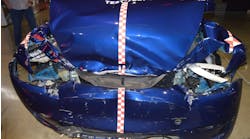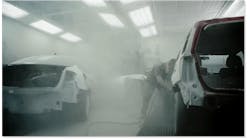According to a 2023 TechForce Foundation report, there are over 30,000 unfilled collision repair technician positions.
This tech shortage is significant enough that industry leaders, such as Caliber Collision, are taking action to combat it, and in unique ways, including through its Technician Apprenticeship Program.
“We started to see a fall-off of people starting to go to technical training schools,” said Eddie Hightower, the senior vice president of sustainability and social responsibility at Caliber Collision. Hightower said this shortage made it difficult not only for Caliber but the entire collision repair industry to hire new technicians.
No Country for Young Men
According to a 2019 research study by Education Next, between 1990 and 2009, as the average number of academic credits high-school students earned increased, the number of vocational credits dropped by 14 percent, or roughly two thirds of a year of vocational studies.
Donna Wagner, assistant vice president of the ASE Education Foundation, added to this topic with FenderBender. “Some of that is fueled by the belief that you need a four-year college degree to be successful,” she said.
Hightower added that interest in other career fields has also been partially responsible in the last few decades. According to the Visual Capitalist, the number of completed bachelor’s degrees for computer and information science jumped by 144 percent from the 2010-11 academic year to the 2020-2021 academic year.
Demographic changes are among the other factors leading to the tech shortage, Hightower pointed out. According to the U.S Census Bureau, there has been a significant rise in the population aged 65 and above. This age group, which accounted for 13 percent of the total population in 2010, increased to almost 17 percent in 2020, marking the highest percentage increase for this age group in the country’s history. This indicates a decline in birth rate, meaning fewer people are entering vocational programs.
These demographic shifts are also shown in the collision repair industry. According to data gathered by Zippa, last updated in July 2023, 63 percent of collision repairers in the U.S. are 40 years or older. The remaining 37 percent are under 40. The data from Zippa also shows, unsurprisingly to many, that the field is heavily male- dominated, with 95 percent being male.
Wagner added that because repairers are much older in this field, there’s more overall reluctance to be educated more on changes in the auto industry, particularly when it comes to ADAS or EVs.
Blueprinting for shortage solution
Part of Hightower’s role at Caliber is to oversee the expansion of the Technician Apprenticeship Program (TAP), which started in 2021.
TAP is a free, hands-on auto body technician training program that pairs a potential apprentice with an experienced technician in a Caliber Collision center to take their skills to the next level – while also getting paid.
“We are the largest multi-shop operator for collision repair centers in the United States,” Hightower said on why Caliber started TAP. “We have about 1,700 locations across 41 states in the United States. We now employ over 31,000 people in those communities across the United States. We knew that our position as leaders in this space is that we not only needed to do something, but we could also do something.”
Hightower described TAP as a competency-based program that lasts a year. He also added that it’s not just targeted at high school or post-high school aged students, they also welcome people of all age groups and backgrounds, especially those who want to make a career change.
What might be seen as the most attractive aspect of TAP is that apprentices are treated just like employees. Not only are they paid, but they also get the same benefits, such as PTO or a 401(k).
“At the end of it, they get a high-paying career,” Hightower said of TAP. “Really, the sky is the limit.”
Although the TAP is open to people of all age groups, Hightower is particularly interested in encouraging younger people to enter the program because younger folks are typically more tech-savvy. “Cars these days are really just computers wrapped in metal.”
It’s not just the vehicles themselves that are more computerized, but the way to obtain the knowledge to fix a particular vehicle is computerized.
“As late as 10 or 15 years ago, when you had a repair procedure you needed to use, you needed to pull down a book, and you were looking up a physical book for a procedure for a particular make and model for a vehicle,” Hightower explained. “Now you’re doing all of that via computer, and on a tablet mostly in the back of our shops.”
“It really isn’t the car repair provider that you would think of sometimes,” he said. “Sometimes you think of the grungy, greasy, oil-stained, dust-everywhere things of the past, no! These are really tech-savvy, tech-forward places where we’re working with computerized technology-loaded vehicles of today. Technology is really an attractor for people entering our TAP program.”
The other reason why the program is attractive to younger people, particularly Generation Z/Zoomers, those people born in the late ‘90s to early 2000s, is that a background in collision repair gives those who have it more control over what they do with their career. Those in TAP are not limited to working in Caliber Collision centers after they complete the one-year apprenticeship.
Hightower also points out that Zoomers, a much more environmentally cautious generation, might stick around with Caliber because they learn about Caliber’s commitment to sustainability. “Just last year, we completed a 100-percent LED lighting retrofit in all of our centers,” Hightower said.
Caliber’s efforts aren’t just focused on getting new technicians, but also retaining older and experienced technicians because “they’re the lifeblood of our apprenticeship program,” he said.
As of February, Hightower reported, Caliber Collision invested more than $65 million into the program, and they’ve graduated more than 1,000 techs out of the program since it started. Soon, they hope to see that number double every year as TAP continues.
Senators and congressmen throughout the land
Hightower said that Caliber has been campaigning for more government support for TAP in the form of grants through the Department of Labor.
“We hope to become a grantee this year,” he said.
“When they (the apprentices) come out of this training program, we’re able to demonstrate to them (politicians) what their earning potential is over time, and they get it,” Hightower said. “They understand the impact on the economy.”
“We’ve talked to conservative members of Congress, progressive members of Congress, independent members of Congress, and everyone has just been so supportive of this program.”
“There’s a lot of support from Capitol Hill because this issue is apolitical.”







